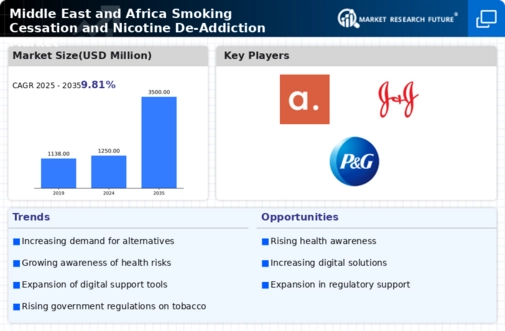Market Trends
Key Emerging Trends in the MEA Smoking Cessation Nicotine De-Addiction Market
Africa and the Middle East’s market concerning smoking cessation and nicotine de-addiction is witnessing significant trends reflective of how the region has changed its approach towards tobacco consumption and public health. Over a few years, there has been this sense of change in perception among many who have over time come to accept the dangers that are accompanied by smoking. This new awareness has led to more demands for products and services related to quitting smoking across MEA.
One such prominent trend is increased uptake of pharmaceutical interventions for smoking cessation. Nicotine Replacement Therapies (NRTs) such as nicotine patches, gum, or lozenges have become popular among those who want to quit addiction to nicotine. These products are readily accessible and effective thereby making them quite popular among people who wish to quit smoking within MEA. Furthermore, pharmaceutical companies are actively engaged in researches aimed at bringing about innovative medicines which are much more efficient than what we have now in the market.
Another important trend observed involves increasing prevalence of anti-smoking programs and campaigns. Governments and health organizations within MEA have intensified efforts of enlightening the society about dangers associated with their habit of smoking while emphasizing upon quitting benefits. Consequently, smokers have become more aware leading a craving for de-addiction programmes themselves. As a result, these programmes have incorporated technology like mobile applications while online support platforms make them convenient or accessible for people trying to stop tobacco use.
E-cigarettes as well as vaping devices are another significant trend in the smoking cessation market for Africa and Middle East regions where it comes from nicotine addiction too. Many individuals see e-cigarettes as being less dangerous than traditional cigarette smoke even if long-term health implications remain uncertain. It is worth noting that because they can be customized with different flavors; e-cigarettes are increasingly becoming popular in this locality particularly due to numberless tastes available in order that one can interchangeably use any type he likes under different conditions so far no any studies have proven any of them to be dangerous though. Nevertheless, the regulatory authorities are closely monitoring this market in order to ensure proper labeling and safety standards are maintained.
The MEA-market dynamics are influenced by social and cultural factors. There is a change in attitudes towards smoking with more emphasis being put on healthy living patterns. Smoking is now socially unacceptable hence smokers would rather quit for themselves as individuals or for their societies. Also, western anti-smoking campaigns and global health initiatives have contributed to such changes in the region.
The economic landscape of the MEA market for smoking cessation and nicotine de-addiction seems to be growing significantly due to investments from both public and private sectors. Healthcare providers are now expanding their services in response to high demand for quitting smoking treatments thus creating an infrastructure which is stronger for those who want support while quitting tobacco products. Additionally, collaborations between pharmaceutical companies with healthcare organizations provide room for innovative practices leading to expansion of these markets.”






Leave a Comment